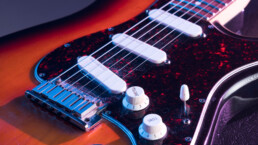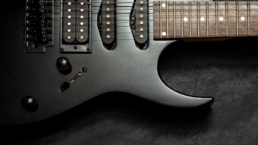In the vast landscape of music, the blues genre stands as a cornerstone, its roots deeply embedded in the soulful expressions of emotion and the raw power of the guitar. As we traverse the modern music era, certain guitarists have emerged as true maestros of the blues, leaving an indelible mark on the genre. Let's take a closer look at some of the most influential blues guitarists who have shaped the landscape of blues guitar in the contemporary era.
RELATED: Learn to play Blues Guitar at TrueFire >
- Stevie Ray Vaughan: The Texas Flood of Blues (1954-1990) Stevie Ray Vaughan, the virtuoso from Texas, is often hailed as one of the greatest blues guitarists of all time. His searing solos and emotionally charged playing breathed new life into the blues in the 1980s. Albums like "Texas Flood" and "Couldn't Stand the Weather" showcased his exceptional talent, and his influence can be heard in the playing of countless guitarists who followed.
- B.B. King: The King of Lucille (1925-2015) The name B.B. King is synonymous with the blues, and rightly so. His expressive vibrato and unique playing style, often accompanied by his beloved guitar "Lucille," left an indomitable impact on the blues scene. The "King of Blues" introduced a new level of sophistication to the genre, bridging the gap between traditional blues and modern styles.
- Eric Clapton: From Cream to Blues Icon (1945-present) Eric Clapton's journey through various musical genres has left an indelible mark on the blues. From his early days with Cream to his solo career, Clapton's bluesy licks and emotionally charged performances have resonated with audiences worldwide. His rendition of "Layla" and the Grammy-winning "Tears in Heaven" showcase the versatility and depth of his blues influence.
- Bonnie Raitt: The Queen of Blues Slide Guitar (1949-present) Bonnie Raitt has not only broken gender barriers in the blues scene but has also become a pioneering force in blues slide guitar. Her soulful voice and masterful slide technique have earned her critical acclaim, and her influence can be heard in the works of many contemporary blues artists. Raitt's ability to fuse blues with elements of rock and folk has expanded the genre's boundaries.
- Joe Bonamassa: A Modern Blues Prodigy (1977-present) In the realm of contemporary blues, Joe Bonamassa stands out as a true prodigy. His technical prowess and dynamic stage presence have earned him a reputation as one of the premier blues guitarists of the modern era. Albums like "Blues of Desperation" and "Royal Tea" showcase Bonamassa's ability to blend traditional blues roots with a modern flair.
Conclusion: The blues guitar landscape in the modern era is a rich tapestry woven by the hands of these influential maestros. From the electrifying riffs of Stevie Ray Vaughan to the soulful notes of B.B. King, the blues continues to evolve and captivate audiences. As aspiring blues guitarists look to the past for inspiration, they find themselves standing on the shoulders of giants, each chord and note resonating with the timeless spirit of the blues. The legacy of these influential guitarists ensures that the blues will continue to strike the right chords in the hearts of music lovers for generations to come.
RELATED: Learn to play Blues Guitar at TrueFire >
November 28, 2023
This holiday season, consider a gift that harmonizes the joy of learning with the convenience of online education. Gifting guitar lessons from JamPlay and TrueFire is a powerful combination that provides an unparalleled musical journey. In this blog, we'll explore why this duo makes the perfect Christmas gift, offering a comprehensive and enriching experience for aspiring guitarists.
RELATED: Give a TrueFire Gift Certificate to the guitarists in your life this Christmas >
Dynamic Duo: JamPlay + TrueFire:
By combining the strengths of JamPlay and TrueFire, you're presenting a comprehensive guitar learning package. This pairing offers an extensive library of on-demand lessons, top-tier instructors, and interactive learning tools. Together, they create a well-rounded educational experience suitable for players of all levels.
Comprehensive Curriculum and Lesson Variety:
JamPlay, known for its structured curriculum, complements TrueFire's diverse lesson library. The combination ensures that your loved ones receive a well-rounded education, covering essential basics to advanced techniques. Whether they want to delve into specific genres, master different playing styles, or explore music theory, the comprehensive curriculum from JamPlay + TrueFire has it all.
Flexible Learning for Busy Lifestyles:
Both JamPlay and TrueFire recognize the importance of flexibility in learning. With on-demand lessons and a vast library available 24/7, your gift recipients can learn at their own pace and schedule. This flexibility is especially valuable for those with busy lifestyles, allowing them to weave the joy of guitar playing seamlessly into their daily routines.
Top-Tier Instructors and Expertise:
JamPlay and TrueFire feature a lineup of world-class instructors, ensuring that your loved ones receive top-tier guidance in their musical journey. From seasoned professionals to renowned artists, the expertise of these instructors adds immense value to the learning experience, offering insights and techniques that can only come from years of mastery.
Conclusion:
This Christmas, gift the ultimate musical experience with JamPlay + TrueFire guitar lessons. The combination of live interaction, personalized feedback, comprehensive curriculum, flexible learning options, and top-tier instructors creates a harmonious blend that caters to the diverse needs of aspiring guitarists. Give the gift of music education that resonates with passion, expertise, and a love for playing the guitar.
RELATED: Give a TrueFire Gift Certificate to the guitarists in your life this Christmas >
November 27, 2023
Embarking on the journey of learning jazz guitar can be both exhilarating and challenging. As you delve into the world of jazz grooves, understanding and mastering the right chords are essential for creating that authentic and smooth jazz sound. In this blog, we'll explore some of the best chords for jazz guitarists aiming to elevate their groove game.
RELATED: Learn from the masters with JamPlay + TrueFire >
Seventh Chords: The Foundation of Jazz Harmony
Jazz is synonymous with seventh chords. Dominant 7th, Major 7th, Minor 7th, and Minor 7th flat 5 chords lay the groundwork for the harmonic richness found in jazz grooves. Experiment with these chords in different voicings and positions to unlock their full potential.
Extended Chords: Adding Flavor to Your Progressions
Elevate your jazz grooves by incorporating extended chords like 9th, 11th, and 13th chords. These extensions add color and sophistication to your playing. Experiment with voicings that suit the mood of the piece, whether it's a laid-back ballad or an up-tempo swing.
Shell Voicings: Streamlined Harmony for Tight Grooves
When diving into jazz guitar, mastering shell voicings is crucial. These minimalist three-note voicings typically include the root, third, and seventh of a chord. Shell voicings provide a clean and concise harmonic foundation, making them perfect for crafting tight and focused jazz grooves.
Drop 2 and Drop 3 Voicings: Crafting Smooth Transitions
Expand your chord vocabulary with drop 2 and drop 3 voicings. These inversions of seventh chords offer a unique sound and are particularly useful for creating smooth voice leading in your jazz progressions. Experiment with different combinations to discover captivating chord transitions.
Altered Dominant Chords: Infusing Tension and Excitement
Jazz thrives on tension and resolution. Altered dominant chords, such as the Dominant 7th sharp 5 or Dominant 7th flat 9, introduce tension that can be resolved in unexpected and exciting ways. Use these chords strategically to add flair and intrigue to your jazz grooves.
Minor II-V-I Progressions: Capturing the Essence of Jazz
The Minor II-V-I progression is a hallmark of jazz harmony. Incorporate minor 7th flat 5 chords in your progressions to capture the authentic jazz sound. Practice navigating these progressions in different keys and positions to enhance your improvisational skills.
Rhythmic Variations: Breathing Life into Your Chords
Beyond the specific chords, mastering jazz grooves involves experimenting with rhythmic variations. Explore syncopation, staccato, and legato techniques to infuse life and personality into your chord progressions. Jazz is not just about what you play but also how you play it.
Conclusion:
As you embark on your journey to master jazz grooves on the guitar, remember that experimentation is key. Explore different chord voicings, experiment with rhythmic variations, and above all, enjoy the process of creating your unique jazz sound. By incorporating these diverse chords and techniques into your playing, you'll be well on your way to becoming a proficient jazz guitarist with a rich and dynamic repertoire. Happy playing!
RELATED: Learn from the masters with JamPlay + TrueFire >
November 24, 2023
As the Thanksgiving feast dust settles and you find yourself contemplating the life choices that led to that third slice of pumpkin pie, there's no better way to digest than with some laid-back guitar tunes. We've curated the perfect playlist for the occasion – a musical journey that'll help you strum your way through the tryptophan-induced haze and keep the family entertained. Plus, we'll sneak in a nifty tie-in with JamPlay + TrueFire's online guitar lessons because why not learn some killer licks while you digest that turkey?
RELATED: Black Friday Blitz is in FULL SWING at TrueFire >
- "Sweet Potato Pie" by James Taylor - A soulful rendition to complement your post-feast dessert. Bonus points if you can replicate the flavor with your fretwork.
- "Gimme Shelter" by The Rolling Stones - Renamed as the "Stuffing Shuffle" for our purposes, this iconic track is perfect for getting into the groove with a funky rhythm that mirrors the chaotic dance of ingredients inside your overstuffed belly.
- "Blue Ain't Your Color" by Keith Urban - Now, imagine a bluesy twist with "Cranberry Blues Jam." Inspired by the sweet and tangy aftermath of cranberry sauce, slide into those notes just like you slid that jelly onto your plate.
- "Superstition" by Stevie Wonder - "Gravy Groove" takes inspiration from the smooth, velvety melody of Stevie Wonder, mirroring the silky texture of the gravy you poured over everything. Just don't spill on your guitar, okay?
- "Blackbird" by The Beatles - Slow things down with "Leftover Lullaby," a soothing tune inspired by The Beatles' classic. JamPlay + TrueFire's online lessons can be your guide, gently leading you into a world of guitar mastery.
Now that you're in the groove, let's talk about how you can take your post-Thanksgiving guitar playing to the next level. JamPlay + TrueFire's Black Friday Blitz is your golden ticket to online guitar lessons that fit your schedule and skill level. Whether you're a novice looking to strum your first chords or a seasoned player aiming for virtuoso status, TrueFire has a course for you.
So, as you wrap up your musical journey through the post-Thanksgiving haze, remember that JamPlay + TrueFire are here to guide you on your guitar-playing adventure. With their Black Friday Blitz, you can snag fantastic deals on lessons and become the guitar hero you were always meant to be. Happy strumming, and may your leftovers be as abundant as your newfound guitar skills!
RELATED: Black Friday Blitz is in FULL SWING at TrueFire >
November 23, 2023
As we age, it becomes increasingly important to find activities that not only bring joy but also contribute to our overall well-being. Playing a musical instrument has long been recognized as a fulfilling and enriching pastime, and for individuals over the age of 55, the acoustic guitar stands out as an excellent choice. In this blog post, we'll explore the top five reasons why acoustic guitars are particularly well-suited for players in this age group.
RELATED: Learn to play guitar at ANY age at TrueFire >
- Gentle on the Fingers: Acoustic guitars are known for their softer strings and lower string tension compared to electric guitars. This characteristic makes them gentler on the fingers, reducing the risk of discomfort or strain. For players over 55, who may have developed sensitivity in their fingertips over the years, the acoustic guitar provides a comfortable and enjoyable playing experience. The ease of fretting and strumming can make learning and playing the instrument a more pleasant endeavor.
- Accessible Learning Curve: Learning to play an instrument can be a daunting task, especially for those who are picking it up later in life. Acoustic guitars often have a more straightforward design, with a simple body structure and minimal electronic components. This simplicity makes the acoustic guitar more accessible for beginners and can be particularly advantageous for older players who may prefer a less technical and intimidating learning curve.
- Therapeutic Benefits: The act of playing an acoustic guitar can have therapeutic effects on both the mind and body. The rhythmic strumming and fingerpicking patterns can promote relaxation and reduce stress, providing a welcome escape from the challenges of daily life. For individuals over 55, who may be facing increased stress or seeking ways to maintain mental sharpness, the acoustic guitar serves as a valuable tool for relaxation and mental well-being.
- Versatility in Musical Styles: Acoustic guitars are incredibly versatile instruments, suitable for playing a wide range of musical styles, from folk and blues to country and classical. This versatility allows players over 55 to explore various genres and find the one that resonates most with their personal taste. The acoustic guitar's adaptability encourages creative expression and ensures that players can enjoy a diverse repertoire, keeping their musical journey exciting and fulfilling.
- Social Connection and Community: Playing the acoustic guitar often opens the door to a vibrant community of fellow musicians. Whether joining a local jam session, participating in a community music group, or connecting with other players online, the acoustic guitar fosters social interaction and a sense of community. For individuals over 55, this social aspect can be particularly valuable, offering opportunities to make new friends, share musical experiences, and enjoy the camaraderie that comes with playing music together.
Conclusion: The acoustic guitar, with its gentle nature, accessible learning curve, therapeutic benefits, musical versatility, and potential for social connection, emerges as an ideal instrument for players over the age of 55. Whether you're a seasoned musician or a beginner, picking up an acoustic guitar can be a fulfilling and enriching journey that contributes to both mental and emotional well-being. So, why not let the soothing sounds of the acoustic guitar accompany you on this harmonious adventure?
RELATED: Learn to play guitar at ANY age at TrueFire >
November 22, 2023
In the symphony of musical history, a single instrument struck a revolutionary chord that echoed through the decades - the first electric guitar. This blog explores the genesis of the electric guitar and how it evolved from a humble beginning to become the iconic instrument that has defined the sound of generations.
RELATED: Learn to play Electric Guitar on TrueFire >
The Genesis:
The birth of the electric guitar can be pinpointed to the early 20th century, a period when musicians and inventors sought ways to liberate sound from the constraints of acoustic instruments. The pioneering figure in this quest was none other than the multifaceted musician and inventor, Les Paul.
Les Paul's Trailblazing Experiments:
In the 1920s, Les Paul embarked on a journey to amplify sound and redefine the possibilities of the guitar. His early experiments involved attaching various pickups, including phonograph needles, to his acoustic guitar. However, it wasn't until the 1940s that he successfully crafted a solid-body guitar, a groundbreaking innovation that laid the groundwork for the modern electric guitar.
The Birth of "The Log":
Les Paul's revolutionary creation, famously dubbed "The Log," was a solid piece of wood with attached strings and pickups. Despite its unorthodox appearance, this prototype became the blueprint for subsequent electric guitars and marked a turning point in musical instrument design.
Commercialization and the Surge to Popularity:
As the 1950s dawned, guitar manufacturers recognized the potential of the electric guitar and began mass production. Notably, Leo Fender introduced the Telecaster in 1951 and the Stratocaster in 1954, solidifying it's presence in the music industry. These instruments quickly gained popularity, offering musicians an unparalleled range of tonal possibilities.
Rock 'n' Roll and Beyond:
The electric guitar's ascent to stardom coincided with the rise of rock 'n' roll in the 1950s and 1960s. Icons like Chuck Berry, Elvis Presley, and Buddy Holly embraced the electrified sound, propelling the instrument into the spotlight. The electric guitar became synonymous with rebellion, individuality, and the core essence of rock music.
Innovation and Iconic Models:
The evolution of the electric guitar continued with a parade of innovative models. From the timeless Gibson Les Paul to the enduring influence of the Stratocaster, each design brought its distinctive characteristics to the forefront. The integration of distortion, feedback, and diverse effects pedals further expanded the sonic horizons, empowering musicians to explore uncharted territories of creativity.
Conclusion:
From Les Paul's audacious experiments to the iconic models that followed, the electric guitar has transcended its humble origins to become a symbol of artistic expression. The journey from "The Log" to the Stratocaster not only reflects the evolution of an instrument but also encapsulates the spirit of human ingenuity and the unending quest to redefine the boundaries of musical expression. The electric guitar's story is a melody of innovation and creativity, resonating through the annals of musical history.
RELATED: Learn to play Electric Guitar on TrueFire >
November 20, 2023
Rock guitar, with its electrifying energy and expressive power, continues to captivate players and fans alike. Whether you're a budding guitarist or a seasoned musician aiming to elevate your skills, these five essential tips will guide you on your quest to rock greatness.
RELATED: Learn from the masters of Rock at TrueFire >
- Meticulous Mastery: Precision in Technique The cornerstone of every great guitarist's journey lies in mastering the fundamental techniques. Dedicate ample time to refining your picking, strumming, and fretting techniques. Pay meticulous attention to hand positioning and posture, ensuring a clean and precise execution. Remember, a rock-solid foundation paves the way for more complex maneuvers down the line.
- Genre Fusion: Expand Your Musical Horizons Rock, a genre known for its diversity, offers a vast landscape of styles ranging from bluesy ballads to hard-hitting metal. Broaden your musical palette by exploring different rock sub-genres. Embrace the nuances of classic rock, delve into the soulful blues elements, and experiment with the intensity of hard rock and metal. Your ability to seamlessly fuse these styles will make your playing both intriguing and dynamic.
- Riff Revolution: Crafting Your Sonic Identity Distinctive guitar riffs are the heartbeat of rock music. Invest time in learning and creating your own riffs to construct a formidable arsenal. Experiment with diverse chord progressions, scales, and rhythmic patterns to develop a signature sound that sets you apart. A killer riff not only adds flair to your playing but becomes the sonic emblem of your unique style.
- Ear Training: Elevate Your Musical Acumen Cultivate the invaluable skill of playing by ear to enhance your musicality. Train your ears to identify chords, scales, and melodies effortlessly. The ability to replicate and improvise based on what you hear not only enriches your musical expression but also facilitates seamless collaboration with fellow musicians. Ear training is the secret weapon that transforms a good guitarist into a great one.
- Tone Craftsmanship: Shaping Your Sonic Landscape Your gear is an extension of your musical identity. While you needn't empty your wallet, investing in a quality guitar, amplifier, and effects pedals can significantly impact your tone. Experiment with different gear combinations to find the sonic landscape that resonates with your style. Crafting your unique sound is an ongoing process that evolves as you explore new possibilities in gear and settings.
Conclusion: Embarking on the journey to become a masterful rock guitarist demands commitment, patience, and an unyielding passion for the instrument. By meticulously perfecting your techniques, embracing genre diversity, crafting unforgettable riffs, refining your ear, and sculpting your sonic identity through quality gear, you're not just playing rock – you're shaping it. So, plug in, turn it up, and let the electrifying spirit of rock propel you to new heights in your musical odyssey.
RELATED: Learn from the masters of Rock at TrueFire >
November 17, 2023
Music has the power to transcend time and age, and learning to play the guitar is a timeless endeavor that knows no boundaries. Whether you're a teenager with dreams of rock stardom or a retiree looking for a new hobby, picking up the guitar is an enriching and fulfilling journey. In this blog post, we'll explore the possibilities of starting guitar lessons at any age and how platforms like TrueFire and JamPlay can be your ultimate companions on this melodious voyage.
RELATED: Learn from the BEST Guitarists in the Biz at TrueFire >
Breaking the Myth of Age Limitations:
One of the common misconceptions about learning to play the guitar is that it's reserved for the young. The truth is, age is just a number when it comes to music. Whether you're 15 or 50, the guitar can become a lifelong companion, offering not just a skill but an escape, a form of expression, and a pathway to creativity.
Benefits of Starting Later in Life:
While it's true that learning new skills might become slightly more challenging as we age, starting guitar lessons later in life comes with its own set of advantages. Adults often bring patience, discipline, and a deeper appreciation for the learning process. The commitment to practice and the ability to connect with emotions can result in a more profound musical experience.
Choosing the Right Learning Platforms - TrueFire & JamPlay:
In the digital age, the internet has opened up a world of possibilities for aspiring guitarists. Online platforms offer convenience, flexibility, and a vast array of resources. TrueFire and JamPlay stand out as beacons in the online guitar lesson landscape. With comprehensive libraries of lessons, courses, and a diverse range of instructors, these platforms cater to all skill levels and musical preferences.
Why TrueFire & JamPlay?
- Expert Instructors: Both TrueFire and JamPlay boast rosters of world-class instructors, each with their unique style and expertise. From blues to jazz, rock to classical, there's an instructor for every genre and skill level.
- Structured Learning Paths: TrueFire and JamPlay's courses are designed to guide learners from the basics to advanced techniques in a structured manner. Whether you're a beginner or looking to refine your skills, these platforms offer clear paths for progression.
- Interactive Learning: Both platforms go beyond passive video lessons. Interactive features, such as private lessons with instructors, facilitate personalized feedback and guidance.
- Variety of Styles: The diverse range of musical styles covered on TrueFire and JamPlay ensures that there's something for everyone. Whether you're into fingerstyle picking or want to shred on an electric guitar, these platforms have you covered.
- Learn at Your Own Pace: The beauty of TrueFire and JamPlay lies in their flexibility. Learners can access lessons at any time, allowing them to practice and progress at their own pace. This is particularly beneficial for individuals with busy schedules.
Conclusion:
Embarking on a guitar-playing journey at any age is a decision that promises not just musical skill but personal growth and satisfaction. Platforms like TrueFire and JamPlay, with their vast resources and expert instructors, stand as beacons for anyone looking to traverse the fascinating world of guitar playing. So, no matter your age, grab that guitar, strum those chords, and let the music begin!
November 16, 2023
Tired of the usual gift-giving humdrum during the holiday season? Say goodbye to the predictable and wrap up something extraordinary this Christmas! Picture the sheer delight on your loved one's face as they tear into their present to reveal the magic within—a brand new guitar! Wondering why a guitar is the ultimate gift? Well, let's dive into the riff-tastic reasons that make it an unforgettable present.
RELATED: Check out TrueFire's 2023 Ultimate Guitar Gear Gift Guide >
1. Shred Your Blues Away:
Why settle for mundane presents when you can gift the power to become a bona fide rockstar? A guitar is not just an instrument; it's a ticket to a world of sonic adventure. Whether they dream of headlining Wembley Stadium or just want to strum away stress, a guitar is the perfect tool to shred away the blues.
2. Harmonize and Humanize:
This Christmas, give the gift of harmony, both musical and emotional. A guitar transforms any gathering into a musical fiesta. Imagine the joy of jamming with friends and family, creating unforgettable memories through impromptu sing-alongs and unplugged performances. It's not just a gift; it's a harmonious celebration waiting to happen.
3. Unplugged Serenity:
In a world that never seems to stop, a guitar offers a serene escape. The gentle plucking of strings is a therapy session for the soul, a melodic oasis amidst the chaos. Gift a moment of tranquility this Christmas and watch as your loved one strums their way to serenity.
4. DIY Serenades:
Move over pre-packaged, store-bought sentiments. A guitar lets you craft your own melodies and serenades. From heartwarming tunes to goofy jingles, the possibilities are as endless as the fretboard. Your loved one becomes the maestro of their own soundtrack, composing the music that defines their life.
5. Brain and Finger Flexing:
Learning to play the guitar isn't just about strumming strings; it's a full-scale workout for the brain and fingers. Sharpening coordination, boosting memory, and enhancing concentration—guitar playing is an exercise regimen that makes you want to dance to your own rhythm.
6. Fashionable Fretwork:
Who needs a statement necklace when you can sport a guitar slung over your shoulder? A guitar isn't just an instrument; it's a fashion statement. Elevate your loved one's style with a touch of musical flair. A guitar says, "I'm not just trendy; I'm here to rock the fashion scene!"
7. A Gift for a Lifetime:
Unlike gifts that lose their charm, a guitar is timeless. It's not just a present; it's an investment in a lifetime of joy. Your gift might be the spark that ignites a lifelong passion or the beginning of a musical journey. Either way, it's a gift that keeps on giving.
This Christmas, ditch the ordinary and opt for the extraordinary. Gift a guitar and watch as the strings of joy resonate through the holiday season and beyond. It's not just a gift; it's a symphony of smiles waiting to be played. Rock on, and have a Merry Christmas! 🎸🎄
RELATED: Check out TrueFire's 2023 Ultimate Guitar Gear Gift Guide >
November 15, 2023
The electric guitar is a versatile instrument that has the power to evoke a wide range of emotions and styles. While the guitar itself is a remarkable tool, it's the addition of guitar pedals that truly opens up a world of sonic possibilities. These compact devices, often underestimated, play a pivotal role in shaping and enhancing the sound of an electric guitar. In this blog, we'll explore the magic of guitar pedals and provide recommendations on some of the best ones to take your playing to the next level.
RELATED: Get TrueFire All Access Today >
I. The Pedal Playground:
Imagine your guitar as a blank canvas, waiting to be painted with various colors and textures. Guitar pedals are the brushes and paints that transform this canvas into a masterpiece. Each pedal serves a unique purpose, altering your guitar's signal in different ways. From distortion and delay to modulation and reverb, the pedalboard is a playground for sonic exploration.
II. Distortion and Overdrive:
Distortion and overdrive pedals are the backbone of many iconic guitar tones. They add grit, sustain, and a touch of rebellion to your sound. Classics like the Tube Screamer or the Boss DS-1 have stood the test of time, providing a warm and responsive distortion that complements various playing styles.
III. Delay and Reverb:
The ethereal sounds of delay and reverb can transport your guitar into otherworldly realms. Whether it's the slapback echoes of rockabilly or the ambient washes of shoegaze, these pedals create a sense of space and depth. Pedals like the Strymon Timeline or the TC Electronic Hall of Fame offer a plethora of options for crafting your sonic landscape.
IV. Modulation Magic:
Modulation pedals, including chorus, flanger, and phaser, add movement and dimension to your guitar tone. These effects have been staples in genres ranging from classic rock to new wave. The Electro-Harmonix Small Clone and MXR Phase 90 are timeless choices that have been embraced by generations of players.
V. Wah-Wah and Expression:
For expressive playing and dynamic control, wah-wah pedals and expression pedals are indispensable. The iconic Cry Baby Wah and the versatile Mission Engineering EP-1 are just a few examples of how foot-controlled effects can add a personal touch to your performance.
VI. Best-of-the-Best Pedals:
- Strymon BigSky Reverb: Known for its studio-quality reverb algorithms, the BigSky offers a vast array of ambient tones.
- Boss DS-1 Distortion: A classic distortion pedal that has found its way onto countless pedalboards, known for its affordability and reliability.
- TC Electronic Flashback Delay: This versatile delay pedal provides a wide range of delay types, from tape echo to modern digital delays.
- EHX Holy Grail Reverb: A compact and affordable reverb pedal with a reputation for delivering lush, classic reverb sounds.
- Ibanez Tube Screamer: A staple in the world of overdrive, the Tube Screamer is celebrated for its smooth, midrange-boosted tone.
Conclusion:
Guitar pedals are the secret sauce that can elevate your electric guitar sound from ordinary to extraordinary. Whether you're chasing vintage tones or pushing the boundaries of sonic exploration, the right combination of pedals can define your unique voice as a guitarist. So, don't be afraid to experiment, build your pedalboard, and let your creativity soar as you unlock the full potential of your electric guitar.
RELATED: Get TrueFire All Access Today >
November 14, 2023










